Abstract
Ethacrynic acid (EA) has been reported to reduce cholera toxin-induced intestinal fluid secretion in the intact animal. We explored the nature of this inhibition in vitro by measuring unidirectional, transmural fluxes of 22Na and 36Cl across isolated rabbit ileal mucosa. Under control conditions (short-circuited mucosa bathed in bicarbonate-Ringer), there was net absorption of Na and Cl. Theophylline (10 mM), cyclic AMP (5 mM), and cholera toxin (added in vivo) abolished net Na flux and produced net Cl secretion. In the presence of either theophylline or cAMP, addition of 0.1 mM EA to the serosal bathing solution abolished net Cl secretion and restored net Na absorption. Cholera toxin-treated mucosa was exposed to 0.05 and 1.0 mM EA. The lower concentration restored net Na absorption but did not significantly reduce Cl secretion. The higher concentration abolished net transport of both Na and Cl. Short-circuit current and Na flux measurements in the presence and absence of glucose indicated that 0.1 mM EA does not inhibit glucose-coupled Na transport. Short-circuit current measurements in the presence of 1.0 mM EA suggested that even this concentration of EA does not inhibit glucose-coupled Na transport. Thus EA appears to specifically inhibit Cl (or NaCl) secretion without inhibiting the absorptive Na “pump.” The anti-secretory effect of 0.1 mM EA does not appear to result from inhibition of adenylate cyclase since secretion stimulated by addition of 5 mM cAMP was abolished. Furthermore, 0.1 mM EA did not significantly reduce theophylline-augmented and cholera toxin-augmented cAMP levels in ileal mucosa. We conclude that EA interacts specifically with the active Cl (or NaCl) secretory mechanism of the small intestine at a step beyond generation of cAMP.
Full text
PDF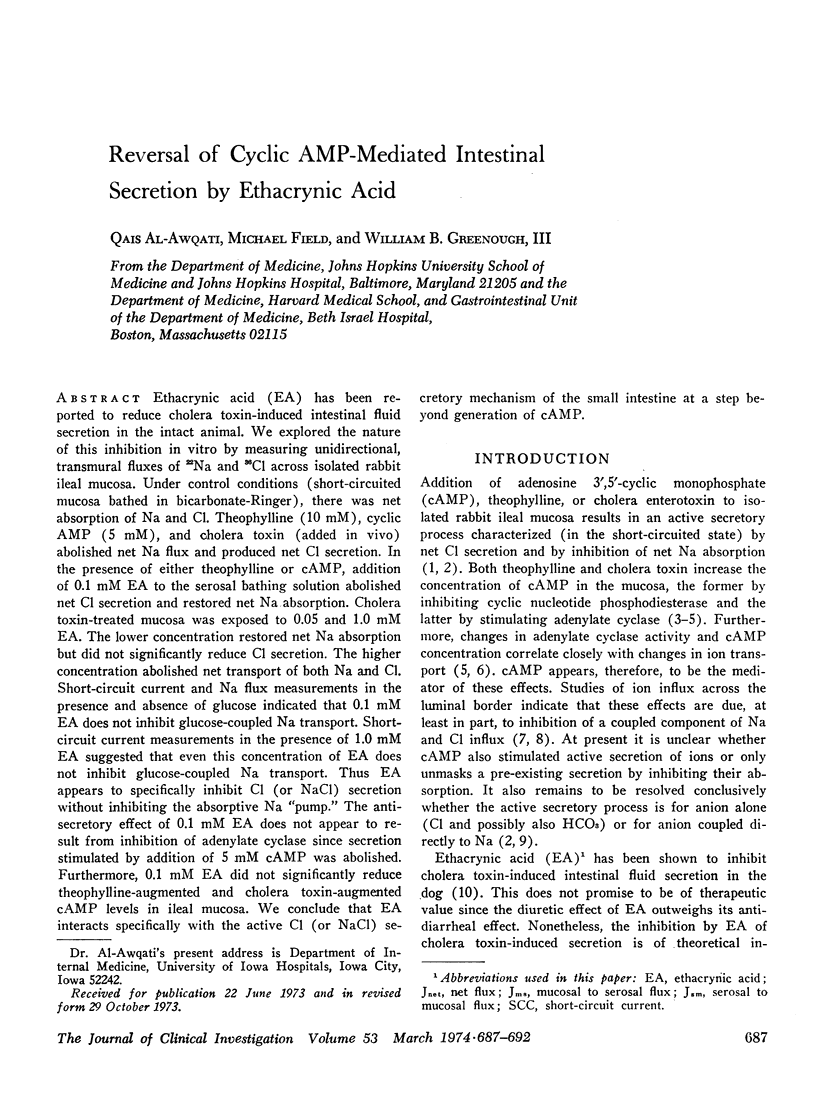
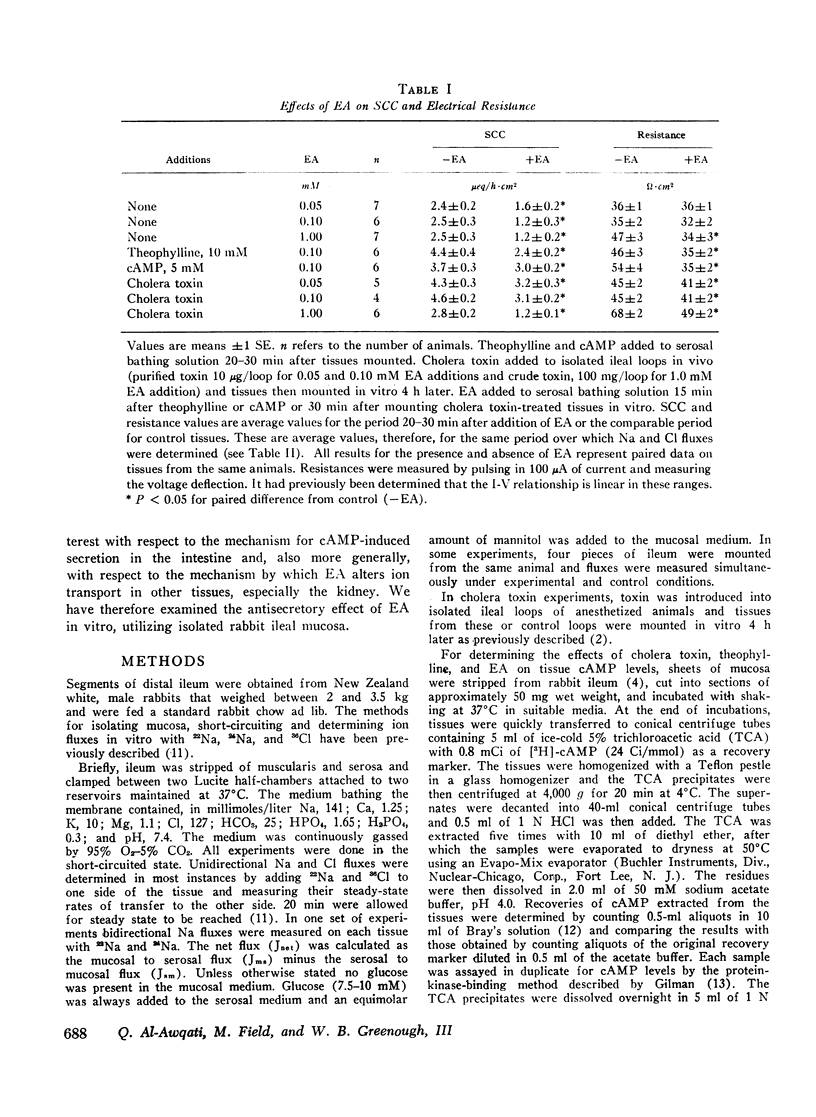
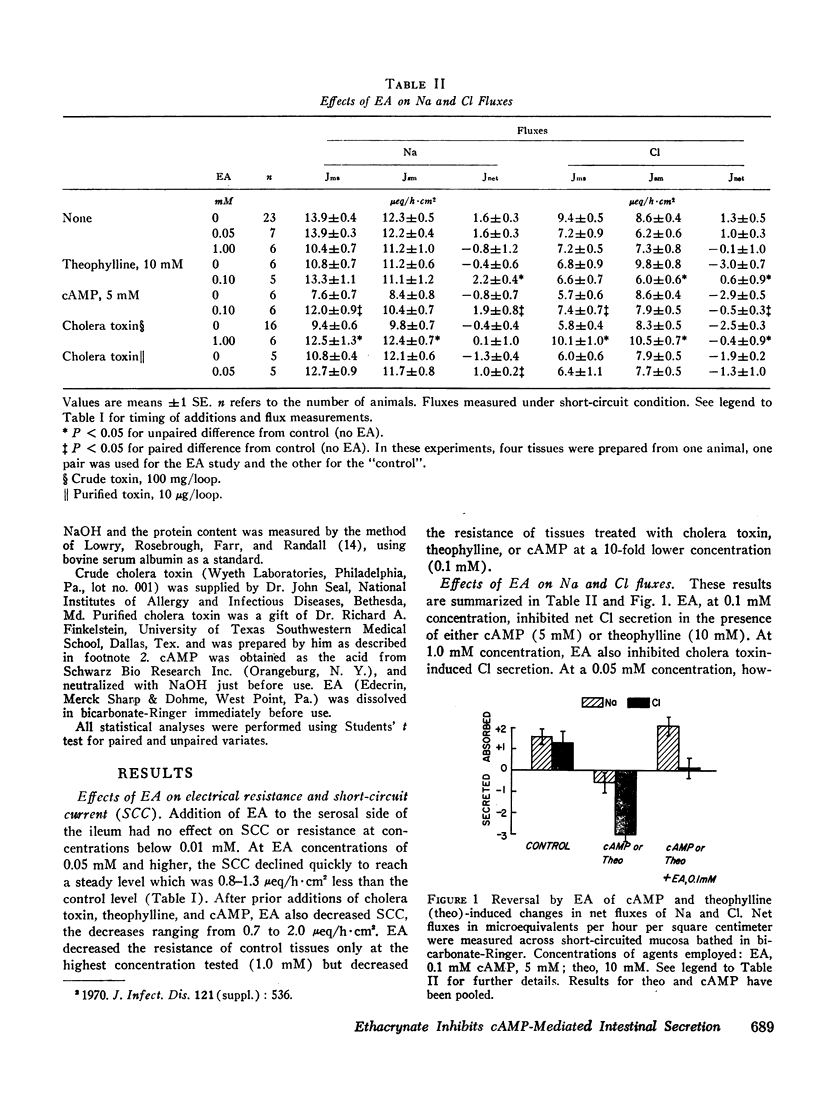
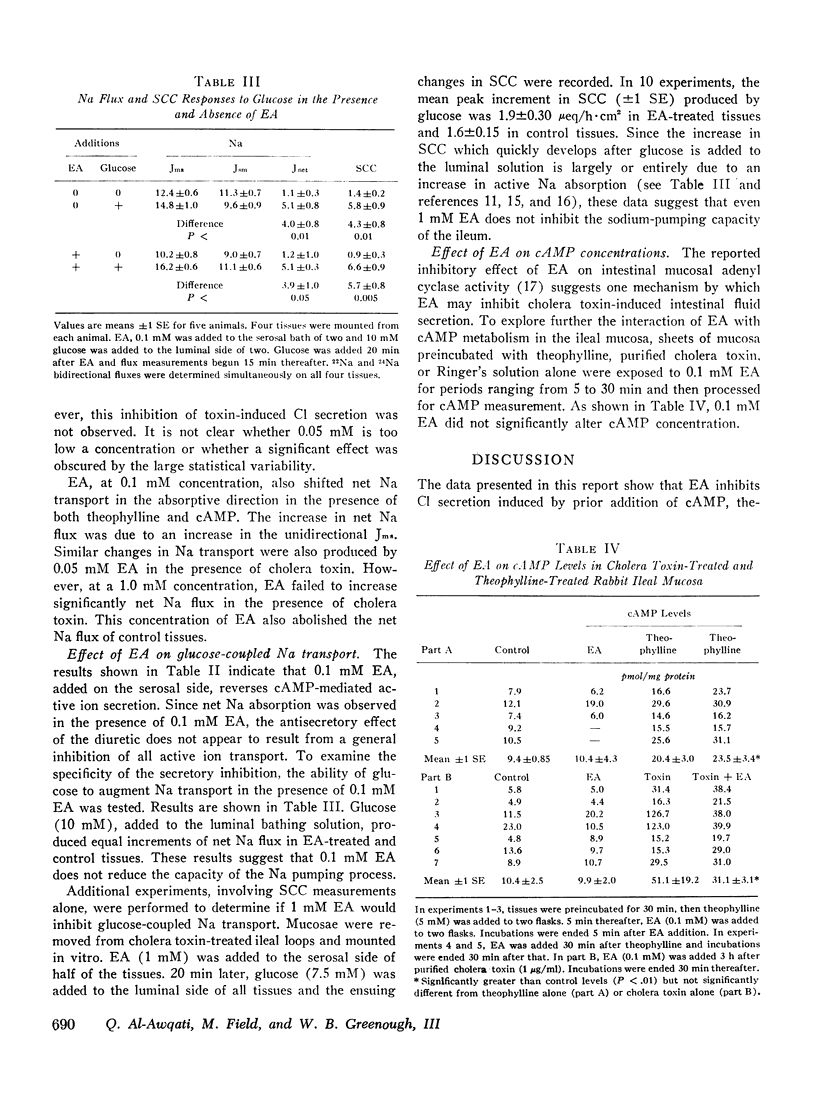
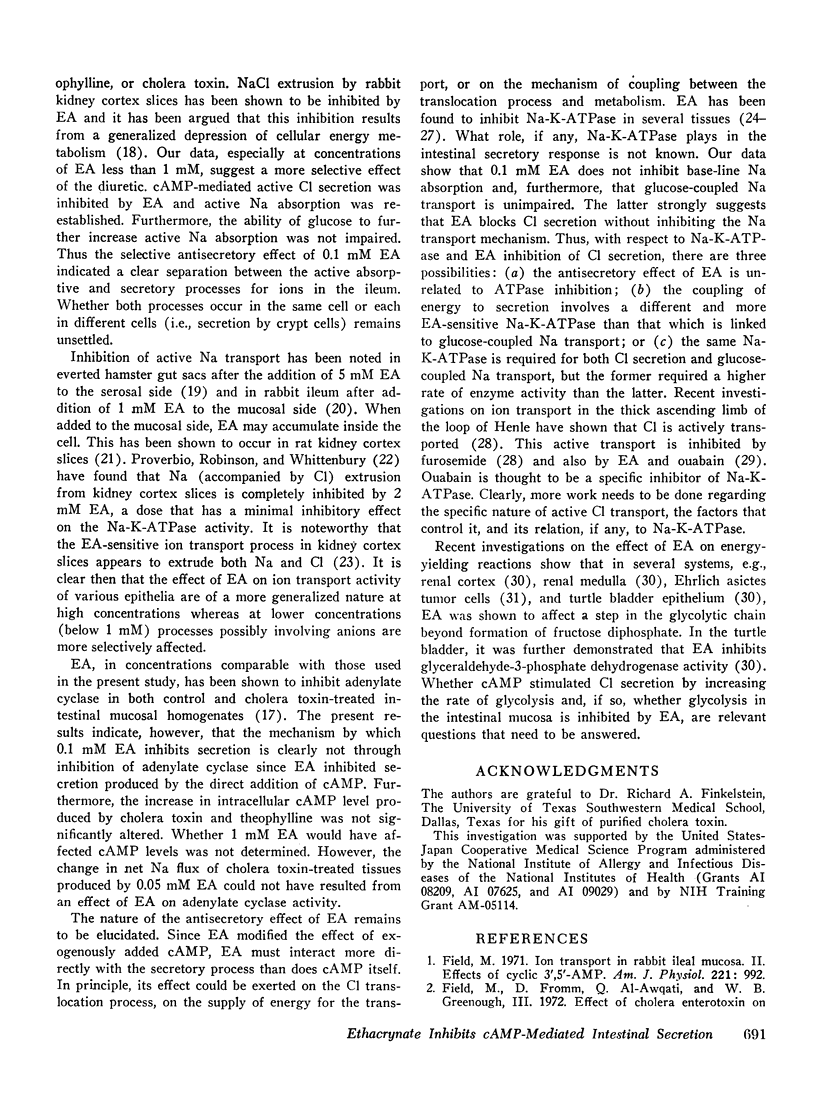
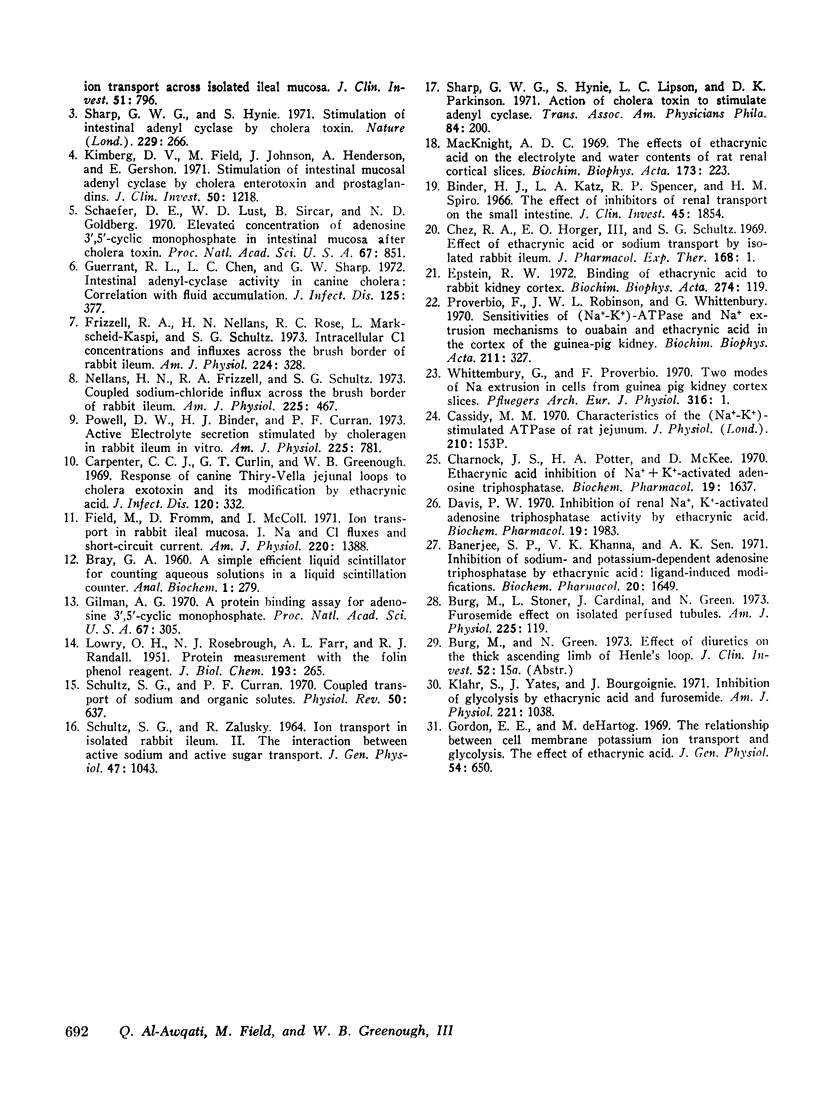
Selected References
These references are in PubMed. This may not be the complete list of references from this article.
- Banerjee S. P., Khanna V. K., Sen A. K. Inhibition of sodium- and potassium-dependent adenosine triphosphatase by ethacrynic acid: ligand-induced modifications. Biochem Pharmacol. 1971 Jul;20(7):1649–1660. doi: 10.1016/0006-2952(71)90293-0. [DOI] [PubMed] [Google Scholar]
- Binder H. J., Katz L. A., Spencer R. P., Spiro H. M. The effect of inhibitors of renal transport on the small intestine. J Clin Invest. 1966 Dec;45(12):1854–1858. doi: 10.1172/JCI105489. [DOI] [PMC free article] [PubMed] [Google Scholar]
- Burg M., Stoner L., Cardinal J., Green N. Furosemide effect on isolated perfused tubules. Am J Physiol. 1973 Jul;225(1):119–124. doi: 10.1152/ajplegacy.1973.225.1.119. [DOI] [PubMed] [Google Scholar]
- Carpenter C. C., Curlin G. T., Greenough W. B. Response of canine Thiry-Vella jejunal loops to cholera exotoxin and its modification by ethacrynic acid. J Infect Dis. 1969 Sep;120(3):332–338. doi: 10.1093/infdis/120.3.332. [DOI] [PubMed] [Google Scholar]
- Cassidy M. M. Characteristics of the (Na+ plus K+)-stimulated ATPase of rat jejunum. J Physiol. 1970 Sep;210(2):153P–154P. [PubMed] [Google Scholar]
- Charnock J. S., Potter H. A., McKee D. Ethacrynic acid inhibition of (Na + +K + )-activated adenosine triphosphatase. Biochem Pharmacol. 1970 May;19(5):1637–1641. doi: 10.1016/0006-2952(70)90152-8. [DOI] [PubMed] [Google Scholar]
- Chez R. A., Horger E. O., 3rd, Schultz S. G. The effect of ethacrynic acid on sodium transport by isolated rabbit ileum. J Pharmacol Exp Ther. 1969 Jul;168(1):1–5. [PubMed] [Google Scholar]
- Davis P. W. Inhibition of renal Na + ,K + -activated adenosine triphosphatase activity by ethacrynic acid. Biochem Pharmacol. 1970 Jun;19(6):1983–1989. doi: 10.1016/0006-2952(70)90294-7. [DOI] [PubMed] [Google Scholar]
- Epstein R. W. The binding of ethacrynic acid to rabbit kidney cortex. Biochim Biophys Acta. 1972 Jul 3;274(1):119–127. doi: 10.1016/0005-2736(72)90287-8. [DOI] [PubMed] [Google Scholar]
- Field M., Fromm D., McColl I. Ion transport in rabbit ileal mucosa. I. Na and Cl fluxes and short-circuit current. Am J Physiol. 1971 May;220(5):1388–1396. doi: 10.1152/ajplegacy.1971.220.5.1388. [DOI] [PubMed] [Google Scholar]
- Field M., Fromm D., al-Awqati Q., Greenough W. B., 3rd Effect of cholera enterotoxin on ion transport across isolated ileal mucosa. J Clin Invest. 1972 Apr;51(4):796–804. doi: 10.1172/JCI106874. [DOI] [PMC free article] [PubMed] [Google Scholar]
- Field M. Ion transport in rabbit ileal mucosa. II. Effects of cyclic 3', 5'-AMP. Am J Physiol. 1971 Oct;221(4):992–997. doi: 10.1152/ajplegacy.1971.221.4.992. [DOI] [PubMed] [Google Scholar]
- Frizzell R. A., Nellans H. N., Rose R. C., Markscheid-Kaspi L., Schultz S. G. Intracellular Cl concentrations and influxes across the brush border of rabbit ileum. Am J Physiol. 1973 Feb;224(2):328–337. doi: 10.1152/ajplegacy.1973.224.2.328. [DOI] [PubMed] [Google Scholar]
- Gilman A. G. A protein binding assay for adenosine 3':5'-cyclic monophosphate. Proc Natl Acad Sci U S A. 1970 Sep;67(1):305–312. doi: 10.1073/pnas.67.1.305. [DOI] [PMC free article] [PubMed] [Google Scholar]
- Gordon E. E., de Hartog M. The relationship between cell membrane potassium ion transport and glycolysis. The effect of ethacrynic acid. J Gen Physiol. 1969 Nov;54(5):650–663. doi: 10.1085/jgp.54.5.650. [DOI] [PMC free article] [PubMed] [Google Scholar]
- Guerrant R. L., Chen L. C., Sharp G. W. Intestinal adenyl-cyclase activity in canine cholera: correlation with fluid accumulation. J Infect Dis. 1972 Apr;125(4):377–381. doi: 10.1093/infdis/125.4.377. [DOI] [PubMed] [Google Scholar]
- Kimberg D. V., Field M., Johnson J., Henderson A., Gershon E. Stimulation of intestinal mucosal adenyl cyclase by cholera enterotoxin and prostaglandins. J Clin Invest. 1971 Jun;50(6):1218–1230. doi: 10.1172/JCI106599. [DOI] [PMC free article] [PubMed] [Google Scholar]
- Klahr S., Yates J., Bourgoignie J. Inhibition of glycolysis by ethacrynic acid and furosemide. Am J Physiol. 1971 Oct;221(4):1038–1043. doi: 10.1152/ajplegacy.1971.221.4.1038. [DOI] [PubMed] [Google Scholar]
- LOWRY O. H., ROSEBROUGH N. J., FARR A. L., RANDALL R. J. Protein measurement with the Folin phenol reagent. J Biol Chem. 1951 Nov;193(1):265–275. [PubMed] [Google Scholar]
- Macknight A. D. The effects of ethacrynic acid on the electrolyte and water contents of rat renal cortical slices. Biochim Biophys Acta. 1969 Mar 11;173(2):223–233. doi: 10.1016/0005-2736(69)90106-0. [DOI] [PubMed] [Google Scholar]
- Nellans H. N., Frizzell R. A., Schultz S. G. Coupled sodium-chloride influx across the brush border of rabbit ileum. Am J Physiol. 1973 Aug;225(2):467–475. doi: 10.1152/ajplegacy.1973.225.2.467. [DOI] [PubMed] [Google Scholar]
- Powell D. W., Binder H. J., Curran P. F. Active electrolyte secretion stimulated by choleragen in rabbit ileum in vitro. Am J Physiol. 1973 Oct;225(4):781–787. doi: 10.1152/ajplegacy.1973.225.4.781. [DOI] [PubMed] [Google Scholar]
- SCHULTZ S. G., ZALUSKY R. ION TRANSPORT IN ISOLATED RABBIT ILEUM. II. THE INTERACTION BETWEEN ACTIVE SODIUM AND ACTIVE SUGAR TRANSPORT. J Gen Physiol. 1964 Jul;47:1043–1059. doi: 10.1085/jgp.47.6.1043. [DOI] [PMC free article] [PubMed] [Google Scholar]
- Schafer D. E., Lust W. D., Sircar B., Goldberg N. D. Elevated concentration of adenosine 3':5'-cyclic monophosphate in intestinal mucosa after treatment with cholera toxin. Proc Natl Acad Sci U S A. 1970 Oct;67(2):851–856. doi: 10.1073/pnas.67.2.851. [DOI] [PMC free article] [PubMed] [Google Scholar]
- Schultz S. G., Curran P. F. Coupled transport of sodium and organic solutes. Physiol Rev. 1970 Oct;50(4):637–718. doi: 10.1152/physrev.1970.50.4.637. [DOI] [PubMed] [Google Scholar]
- Sharp G. W., Hynie S., Lipson L. C., Parkinson D. K. Action of cholera toxin to stimulate adenyl cyclase. Trans Assoc Am Physicians. 1971;84:200–211. [PubMed] [Google Scholar]
- Sharp G. W., Hynie S. Stimulation of intestinal adenyl cyclase by cholera toxin. Nature. 1971 Jan 22;229(5282):266–269. doi: 10.1038/229266a0. [DOI] [PubMed] [Google Scholar]
- Whittembury G., Proverbio F. Two modes of Na extrusion in cells from guinea pig kidney cortex slices. Pflugers Arch. 1970;316(1):1–25. doi: 10.1007/BF00587893. [DOI] [PubMed] [Google Scholar]


